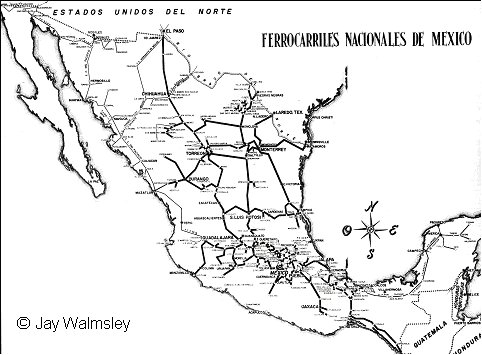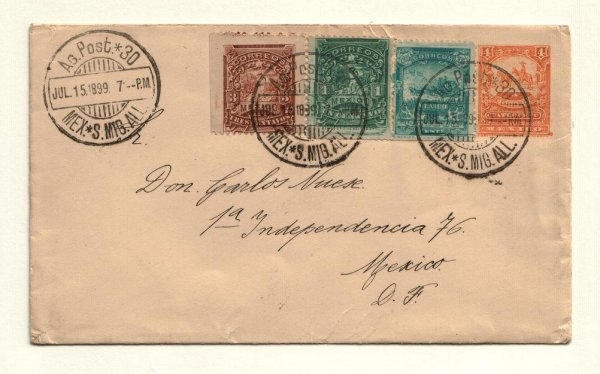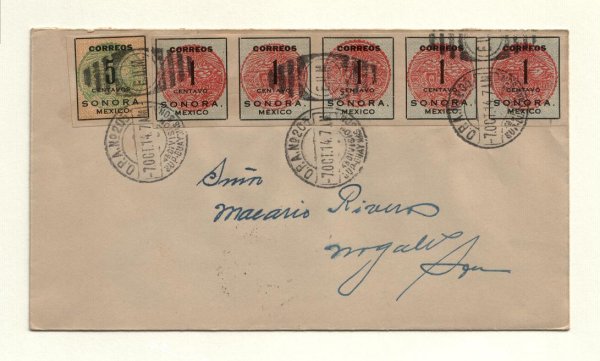TPO -> The TPOs of Mexico
The TPOs of Mexico
By Jay Walmsley
Start and finish dates: 1880s to sometime in the 1970s
 The map is a copy of the official map issued by the Ferrocarriles Nacionales de Mexico
in 1960, at which time the railways were probably at their most extensive.
Mexico, a North American country, is vast and the railroad network was huge.
The map is a copy of the official map issued by the Ferrocarriles Nacionales de Mexico
in 1960, at which time the railways were probably at their most extensive.
Mexico, a North American country, is vast and the railroad network was huge.
In the 1840s minor railways based on Mexico City and Vera Cruz made their appearance but it was not until 1873 that the first major railway, the Ferrocarril Mexicano, was built to link the capital, Mexico City, with the major port of Vera Cruz, the most important port on the Gulf of Mexico. This was the traditional trade route between the capital and the sea.
The next major development was the building of the Ferrocarril Central Mexicano between El Paso, Texas, 1,224 miles to Mexico City. Built by an American company, the Santa Fe, it forestalled their rivals, the Denver and Rio Grande, who built a three foot gauge line, the Ferrocarril Nacional Mexicano from Laredo to Mexico City, finally completed in 1888. The Central was the backbone of the railroad system and its tentacles spread far and wide.
Other major railroads appeared and everywhere small railways serving mines or small towns sprang up. Gradually the gaps in the map were filled, one of the most important being the spread of the Southern Pacific down the Pacific Coast finally linking in the south with the major system in 1927.
The Mexican Revolution in 1912 to 1919 was a major civil war which killed millions and severely damaged the railroad system. In 1912 there were 160 TPOs running but only half this number by the time peace was restored. TPOs were always an important part of the mail system and only the competition of motorised transport caused them be cut back and ultimately cease.
The cancellations of the TPOs are numerous. The first types were the Conductor or Agente type or with specific terminal points. These were followed in about 1894 by the circular Ambulante types with an abbreviation of the terminal points. Following these came the circular railroad types inscribed with the railroad abbreviation and a numbered Ambulante. These were used with the numbered grid killers.

1899 Ag(ente) Post(al) 30, used between Mexico City and San Miguel Allende
In the late 1890s came the Ag Post (Agente Postal) series numbered from 1 to about 200. These too showed the terminal points and as such each cancellation is very informative. This series was issued when the system was growing and sometimes the handstamp had to be changed to reflect the new terminal points. This series was followed by the OPA series (Oficina Postal Ambulante) numbered from 1 to well into the 900s. Showing at first terminal points, gradually they were changed to show the railroad, making their use more flexible. This series was in use during the Revolution and handstamps can be found used well away from where they should be. Named OPA types are a late variant.

1914 O(ficina) P(ostal) A(mbulante) N0 205 used by the Supernumerario (spare clerk) based at Guaymas, Sonora
The Servicio Ambulante numbered series came next. Being numbered but with no other information, their allocation to routes is dependent on useful covers. The OPA Republica Mexicana came next, with both series numbering several hundred. Transportes and Transbordos completed the major series.
Collecting the postal markings is fascinating and great fun. There are several thousand to be found, a few very common, the majority not so. Everyone can find something unknown, something unique, and the body of knowledge is slow to grow. Have fun finding them.
References
The following books are recommended:-
Railroads in Mexico by Francisco Garma Franco Volumes I and II published by Sundance Publications Limited, 250 Broadway, Denver, Colorado 1995 and 1988 respectively.
Mexican Narrow Gauge by Gerald M Best published by Howell-North Books, Berkeley, California 1971.
The Southern Pacific of Mexico and the West Coast Route by John R Signor and John A Kirchner published by Golden West Books, San Marino, California 1987.
To learn more about the TPOs, The Travelling Post Offices of Mexico by Thomas K Todsen and Jay Grace Walmsley
was published in 2008 but rapidly sold out. This book provides a comprehensive account of the TPOs and the cancellations in use.
A second edition, with masses of additional information, is now available: follow this link.

